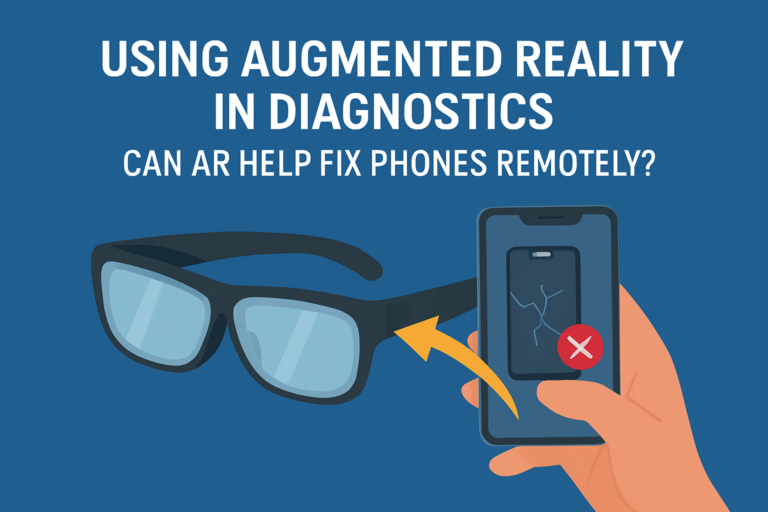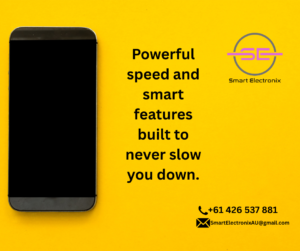
Technology is reshaping the way we repair our devices. In recent years, Augmented Reality (AR) has gone from a futuristic concept to a practical tool used in retail, healthcare, and even education. Now, the repair industry is asking the same question: Can AR help diagnose and even fix phones remotely?
In this article, we’ll explore how AR is being used in diagnostics, the benefits for consumers and repair shops, and whether it could be the future of phone repair.
What Is Augmented Reality in Diagnostics?
Augmented Reality overlays digital information onto the real world. Imagine pointing your phone’s camera at a damaged device, and an AR app highlights potential problem areas — a swollen battery, loose screws, or a misaligned screen.
In diagnostics, AR can help:
-
Guide users step by step through troubleshooting.
-
Highlight physical components like ports or buttons with visual instructions.
-
Connect with remote technicians, who can annotate your live camera feed to show exactly what to check.
This creates a hands-on learning experience for the customer while reducing the need for physical visits.
How Remote AR Diagnostics Works
Here’s a simple breakdown of how AR-based phone diagnostics could work in practice:
-
The customer opens an AR app on their phone or a web-based AR support tool.
-
They point their camera at the faulty phone (using another device) or at the inside of the device if it’s already partially opened.
-
AR software overlays instructions, such as “Check if the battery connector is loose” or “This screw needs tightening.”
-
A technician joins remotely, marking exact areas on the customer’s live video feed.
-
The system logs the issue, creating a repair report with annotated images and recommended fixes.
Instead of waiting days for a repair quote, users could get instant clarity on whether the problem requires professional service or a simple adjustment at home.

Benefits of AR Diagnostics in Phone Repairs
1. Faster Problem-Solving
Traditional diagnostics often require mailing or bringing in a device. With AR, customers can get real-time answers from the comfort of their home. For small issues (like a dirty charging port), AR guidance might even fix the problem on the spot.
2. Cost-Effective
Not every issue requires a workshop visit. By diagnosing remotely, customers avoid unnecessary inspection fees. Shops also save technician time by filtering out minor issues before devices come in.
3. Reduced Downtime
Phones are essential daily tools. With AR diagnostics, you don’t need to be without your device for days just to find out what’s wrong — the problem can be identified within minutes.
4. Enhanced Customer Experience
Customers appreciate transparency. Being able to see and understand what’s wrong with their phone in real time builds trust with the repair shop.
5. Training for New Technicians
Beyond consumer support, AR is a powerful training tool. New technicians can use AR overlays to learn repair steps, reducing errors and boosting confidence.

Challenges of AR Diagnostics
As exciting as AR is, it’s not without limitations:
-
Hardware requirements: Customers need a secondary device (like another phone or tablet) to capture video of the faulty phone.
-
Technical complexity: Some phone issues (e.g., motherboard faults) can’t be diagnosed visually.
-
Security and privacy: Customers may hesitate to stream live video of their devices or surroundings.
-
DIY risks: Overly complex guidance might encourage untrained users to attempt risky repairs, potentially causing further damage.
For these reasons, AR won’t replace professional repairs — but it can complement them.
The Future: Hybrid Repair Models
The most realistic future for AR diagnostics is a hybrid model:
-
Step 1: AR identifies and logs potential issues remotely.
-
Step 2: The customer decides whether to bring the device in or book a technician.
-
Step 3: The shop uses the AR diagnostic report to speed up repairs.
This creates efficiency for both sides. Customers feel empowered, while technicians save time on basic inspections.
Real-World Examples on the Horizon
-
Tech support apps: Some brands are already testing AR-powered customer support, where agents circle parts of your screen or hardware during a live video call.
-
Enterprise repair companies: Businesses managing fleets of devices are exploring AR to quickly troubleshoot employee phones remotely.
-
Smart accessories integration: Imagine scanning your charging cable with AR and being told it’s faulty, rather than assuming your phone’s battery is dead.
These examples show that AR repair diagnostics isn’t just theory — it’s beginning to roll out in real scenarios.
Final Thoughts: Can AR Really Fix Phones Remotely?
Augmented Reality won’t completely replace hands-on repairs, but it will play a transformative role in diagnostics and troubleshooting. By empowering customers, streamlining inspections, and improving communication between users and technicians, AR could redefine the repair industry in the coming years.
So, can AR help fix phones remotely? Not entirely. But it can absolutely diagnose issues faster, reduce unnecessary visits, and make repairs more transparent. For customers, that means less downtime and more confidence. For shops, it means efficiency and happier clients.
In short: AR isn’t replacing your repair shop — it’s making it smarter.
